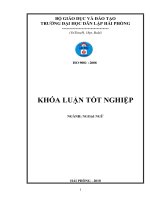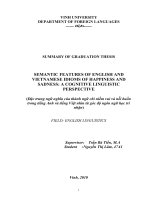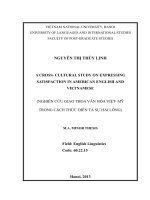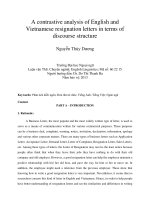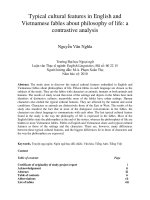A study on the syntactic features of english and vietnamese lyrics adopting the functional grammar approach clause as a message
Bạn đang xem bản rút gọn của tài liệu. Xem và tải ngay bản đầy đủ của tài liệu tại đây (134.61 KB, 13 trang )
1
MINISTRY OF EDUCATION AND TRAINING
UNIVERSITY OF DANANG
---------
NGÔ THỊ PHƯỚC YÊN
2
The study has been completed at College of Foreign Languages,
University of Danang
Supervisor: NGUYỄN THỊ TUYẾT, M.A
Examiner 1:
A STUDY ON THE SYNTACTIC FEATURES OF
ENGLISH AND VIETNAMESE LYRICS ADOPTING
THE FUNCTIONAL GRAMMAR APPROACH -
Examiner 2:
CLAUSE AS A MESSAGE
Field: THE ENGLISH LANGUAGE
The thesis was defended at the Examination Council for the M.A.
theses, University of Danang.
Time: 30/10/2010
Venue: University of Danang
Code: 60.22.15
M.A. THESIS IN THE ENGLISH LANGUAGE
(A SUMMARY)
Supervisor: NGUYỄN THỊ TUYẾT, M.A
The original of this thesis is accessible for the purpose of reference at:
- Library of the College of Foreign Languages, University of Danang.
- The Information Resources Center, University of Danang.
DANANG – 2010
3
4
CHAPTER 1
communication. It is true that grammatical competence is a part of
INTRODUCTION
communicative competence for one cannot learn and speak well a
foreign language without knowing anything about its grammar,
1.1. RATIONALE
Language is one of the most prominent factors that make
human beings different from other creatures. We express our ideas
through language, which is considered the most effective means of
communication. To achieve effective and coherent communication,
we have to combine vocabulary and wording. This is because of the
association grammar rules, forms and structures with aspects of
meaning or semantic functions over the lexical meaning of individual
word. In other words, we cannot separate the structure of a language
from its functions and meanings. Therefore, it is extremely necessary
to study grammar- the mechanism of the combination.
Therefore, language and its mechanism have been taught at
school as part of the curriculum. However, teachers and students pay
much more attention to the vocabulary and grammar of a language
than to the making use of grammatical knowledge in order to have
effective communication. A typical example of this is the teaching
and learning of English as a foreign language at Vietnamese school:
even though the Communicative approach to language teaching and
studying has been introduced for quite long, it is still very common
that we focus on grammar as simply a set of rules rather than an
effective means of communications. The result is that after some
years of English studying, all the learners can do is working with
exercises repeatedly and still find it difficult to use English in
however, the teaching and studying of grammar solely is not
sufficient for communicative purposes. Thus, what matters most is to
decide which approach to grammatical analysis to adopt and how to
transfer it at school.
On the other hand, if the communication is to be successful
then organization is a major problem, which must be solved. One of
the constraints on the speaker/writer when producing their message is
that they can produce only one word at a time. Therefore, they have
to choose a beginning point for their utterance. The initial place has
an enormous importance in the clause and in discourse. Whatever is
at the first place will influence the hearer/reader’s interpretation on
everything that comes next in the discourse since it will constitute the
initial textual context for everything that follows.
There are many different approaches to language studying. One
of the most noticeable branches of modern linguistics is functional
grammar, which provides insights into not only the meaning but also
the effectiveness of a text or a discourse. “It sees language first and
foremost as a system of communication and analyzes grammar to
discover how it is organized to allow speakers and writers to make
and exchange meanings.” The tendency to approach a functional
analysis in language is inevitable since language has developed for
5
6
the satisfaction of human needs and the way it is organized is
meaning in the best way adopting the light of Functional grammar,
functional with respect to these needs.
we attempt to make an investigation into the Theme-Rheme structure
As a teacher at Danang Vocational training College, we have
realized that almost Vietnamese students like English songs. They
have chance to “encounter” them from any kind of public media as
well as every corner of cafeteria or cell phone bell. Therefore, to
create the conditions for create teaching, the use of popular culture is
a key to effective teaching and learning because it provide learners
with some forms of meaning in a relevant and concrete way.
from English and Vietnamese popular lyrics.
1.2. SIGNIFICANCE OF THE STUDY
We hope that this research gives benefit in some aspects as
follows:
1. The researcher gives information to the reader about the
thematic structure in English and Vietnamese popular songs.
2. The research can give some benefits to for another researcher
Authentic materials, such as western movies and songs are good
as the next
referent for further research, especially in the
resources to lead learners to develop a genuine interest in learning a
thematic structure in song lyrics.
language and which can sustain long-term learning. Since popular
1.3. AIMS, OBJECTIVES AND RESEARCH QUESTIONS
song appeals to learners, they are motivated to become active and are
1.3.1. Aims
eager to know the meaning of the lyrics and sing the songs repeatedly
themselves.
Consider the lyrics in the light of Functional grammar we will
study the Theme-Rheme structure of pop lyrics in fifty English songs
Beside, as we live the global era, an age of information, there
and fifty Vietnamese songs, classify them into different types, and
are many channels that audiences can turn to get news or information
draw out the possible similarities and differences in semantic,
to suit their needs. Since the interest in Vietnam and Vietnamese
cultural and pragmatic features.
language has increase considerably in the last few years. Sometimes
1.3.2. Objectives
surprisingly, we meet people from Japanese, England, or other
Western countries present Vietnamese songs successfully. Most of
foreign people, who would like to discover Vietnamese culture
through Vietnamese songs, all approach to Trịnh Công Sơn’s music.
Thus, being aware of the importance of popular songs to
language learners as well as how to comprehend and catch the lyrics
There are three objectives to guide the study:
1. To describe, compare and identify the similarities and
differences between the thematic structures of the two languages.
2. To draw out illocutionary acts realized through the thematic
structure.
7
8
3. To suggest some implications for English learning and
Theme is realized in English by first position in a clause. The
teaching through songs
definition of Theme given by Halliday [24, p.38] is that Theme is the
1.3.3. Research questions
given information serving as “the point of departure” of a message.
The following questions are posted to guide the research
process:
Halliday also defines Theme as the element, which serves as
the point of departure of the message. It is that with which the clause
1. What is the Theme-Rheme structure of English lyrics?
is concerned. Therefore, the Theme is not necessarily a nominal
2. What is the Theme-Rheme structure of Vietnamese lyrics?
group. It may be an adverbial group or preposition phrase.
3. What are the similarities and differences in the semantic,
syntactic aspects in the Theme-Rheme structure of English-
•
Rheme
“Rheme is the remainder of the message except the Theme. It is
Vietnamese lyrics?
all that is left over in the clause after we pick up the Theme.”
1.4. SCOPE OF THE STUDY
1.6.1.2. Vietnamese
This research will study the semantic, pragmatic and cultural
aspects as well as the characteristics of the Theme-Rheme structures
•
Theme
Nguyễn Văn Hiệp [54, p.61] states that that the only subordinate
in fifty English popular songs and fifty Trinh Cong Son’s songs.
components that take the position before the nucleus of the sentence
1.5. ORGANIZATION OF THE STUDY
are the Topic. (Khởi ngữ).
There are five chapters in this study.
Chapter 1: Introduction
Chapter 2: Review of Literature
Chapter 3: Methods and Procedures
Chapter 4: Findings and Discussion
Chapter 5: Conclusions and Implication
•
Rheme
Trần Ngọc Thêm [63, p.50] states that “A sentence often has
two parts: one is the syntactic centre (organizing centre) of the
sentence, called the Theme; the other is the semantic centre of the
sentence, called the Rheme. It always stands after the Theme.
“When people speak out a sentence they create a Theme and then
1.6. DEFINITION OF TERMS
1.6.1. Definitions of Theme and Rheme
1.6.1.1 English
•
Theme
they say something about the Theme or within the scope suggested
by the Theme.”(by Cao Xuân Hạo) (Sơ thảo ngữ pháp chức năng) or
1.6.2. Definitions of lyrics
1.6.3. Definition of popular songs
9
10
CHAPTER 2
and Tran Ngoc Them [63] both use the Theme-Rheme concepts to
describe the core of Vietnamese sentence. From 70s, Luu Van Lang
LITERATURE REVIEW
[59] tended to analyze sentences on the basic of hierarchic phrase
2.1. LITERATURE REVIEW ON SYSTEMIC FUNCTIONAL
LINGUISTICS
a new life into national linguistic with the launching of the book
Systemic Functional Linguistics (SFL) is a theory of
language. It focuses on language function. SFL grew out of the work
of JR Firth, a British linguist of the thirties, forties and fifties, after
which it was mainly developed by his student Michel Halliday.
Halliday developed the theory in the early sixties. In 1994, his ideas
were gathered together in his book “An introduction to Functional
grammar” (second edition, 1994). On the next ten years, in 2004, the
third edition of “An introduction to Functional grammar” was
published; Michael Halliday and Christian Matthiessen (third edition,
2004) reviewed this editor. In addition, SFL theory has been explored
and taken further by JR Martin, Christian Matthiessen, and Clare
Painter [28]. Many other linguists had followed Halliday’s theory and
further studied them in many other works including the Bloors [4],
David Butt’s [13], Simon Dik’s [40], Susan Eggins’[14], Tamin
Givón [20], Graham Lock’s [22], Martin’s [34] and so on.
Nowadays, SFL is especially influential in areas of language
development, education linguistics, literacy, stylistics and it has
spread to a number of institutions throughout the world.
of
Vietnamese
sentence
structures
“Tiếng Việt- Sơ thảo ngữ pháp chức năng- Tập 1” [Vietnamese
language-preliminary of functional grammar, Volume 1]. Cao Xuan
Hao’s viewpoint is supported by several studies in international
linguistics, for example, applying findings by Li and Thomson about
subject-prominent or topic-prominent languages to Vietnamese.
In recent years, functional grammar theory in both English
and Vietnamese has been studied widely. To some extend, these
study contribute to the Vietnamese grammar, such as Nguyen Thi
Anh [49] with the study on the realization of Theme in English and
Vietnamese sentences; Phan Van Hoa [56] with the study on sentence
structures with unusual order in English and Vietnamese. Nguyễn
Thị Thìn studies the thematic structure as a cohesive device of
creating textual in English and Vietnamese; Nguyen Thi Phuoc Tra
master thesis on the Thematic structure in English and Vietnamese on
functional and pragmatic aspects [45] Siriporn Woochaiyaphum [41]
analyzes the textual metafunction of Vietnamese online new reports.
Tran Le Nghi Tran [46] master thesis on the Theme-Rheme structure
of English and Vietnamese proverbs, and so on.
In Vietnam, during the 70s and 80s, there were notable
discoveries
with the Theme-Rheme core. In the early 1990s, Cao Xuan Hao blew
and
their
corresponding functional semantic features. Diep Quang Ban [50]
2.2. THEORITICAL CONCEPTS
2.2.1. The three aspects of meaning of a clause
11
Halliday [24] has defined the three different modes of
meaning inside the clause:
12
culture, the interpersonal metafunction relates to the context of
situation, and the textual metafunction relates to the verbal context.
The Subject is a function in the CLAUSE AS AN
The textual metafunction [24, p.30] is one of three concepts in
EXCHANGE. The element is held responsible: in which is vested the
systemic functional linguistic that relates to two metafunctions:
success of the clause in whatever is its particular speech function.
interpersonal and ideational. It is relevance to the context of situation.
The Actor is a function in the CLAUSE AS A
The textual function of the clause is that of constructing a message.
REPRESENTATION. It is the active participant in the process: the
Its major grammatical system is THEMATIC structure.
one that does the deed.
2.2.3. The information and Thematic structure in English
The Theme is function in the CLAUSE AS A MESSAGE. It
A sentence expresses a statement made about how the
is what the message is concerned with: the point of departure that the
speaker perceives a state of affairs, and his perception may be stated
speaker is going to say.
more than one way, depending on how it is reorganized in his
2.2.2. The metafunctions and three meanings in a clause
thought.
Halliday developed a theory of the fundamental functions of
2.2.4. The information and Thematic structure in Vietnamese
language, in which he analyzed lexicogrammar into three broad
In CaoXuanHao book [55], he states, “The theme is the
metafunctions: ideational, interpersonal and textual. Each of the three
domain of applicability of the Rheme, it may represent an entity, a
metafunctions is about a different aspect of the world, and is
space, a time, or a condition frame within which it makes sense to
concerned with a different mode of meaning of clauses. The
say what follows. The role of the Theme is to restrict the limits of
ideational metafunction is about the natural world in the broadest
relevancy of the statement (the Rheme), to give it a framework
sense, including our own consciousness, and is concerned with
without which the sentence could not have a truth-value, and hence, a
clauses as representations. The interpersonal metafunction is about
communicative efficiency.
the social world, especially the relationship between speaker and
In a discourse, sentences have the communicative function,
hearer, and is concerned with clauses as exchanges. The textual
which means they express messages (and not represent a
metafunction is about the verbal world, especially the flow of
proposition); therefore, sentence syntactic structure should be
information in a text, and is concerned with clauses as messages. It
identified in conformity with this function. Accordingly, we support
seems clear here: the ideational metafunction relates to the context of
the view that sentence syntactic structure is organized in terms of
13
14
thematic structure, in which Theme is the part which expresses “what
4.1.1. The identification of Theme-Rheme and their boundary in
is talked about” or the “starting point” of the message (and not only
the English clause
subject of the logical proposition) and Rheme is the part which
4.1.2. The types of Theme in English clauses
contains information the speaker wants to talk about the theme (and
4.1.2.1. Textual, interpersonal, topical/ideational Theme
not only predicate of the logical proposition). This Theme-Rheme
•
Topical or Ideational Theme
analysis could be applied to all types of sentences (narrative,
Complement and Subject as topical Theme
interrogative, request, exclamative) which are different from many
Adjunct as topical Theme
researchers who think it could be applied only to narrative sentences.
In conclusion, the notion of Theme in English and
Vietnamese is, basically, quite similar, as the “point of departure of a
message”, or, “starting point of a judgment”. They are all about what
Deep as sea, wide as sky
Adjunct
Topical Theme
•
the message is concerned.
Rheme
Interpersonal Theme
Vocative as interpersonal
CHAPTER 3
ThemeModal Adjuncts as interpersonal Theme
METHODS AND PROCEDURE
Finite verb also is used as interpersonal Theme
3.1. RESEARCH DESIGN
•
Textual Theme
Conjunction as textual Theme
3.2. RESEARCH PROCEDURE
Conjunctive Adjunct as textual Theme:
3.3. DESCRIPTION OF SAMPLE
Wh-element as textual Theme
3.3.1. English songs
3.3.2. Trịnh Công Sơn’s songs:
3.4. VALIDITY AND RELIABILITY
CHAPTER 4
RESULTS AND DISCUSSION
4.1. THE THEME-RHEME STRUCTURE OF ENGLISH
LYRICS
the beauty of our love paints rainbows [94]
4.1.2.2 Halliday’s division
A. Simple Theme of more than one constituent
Sweet deceit
come calling.
All I can do
is just think about you.
Theme
Rheme
B. Unmarked and Marked Theme:
Subjects are most Unmarked Theme
[92]
[86]
15
Preposition phrase as Marked Theme
Complement as high Marked
• Interrogative
• Theme in imperative sentences Verbal group
C. Multiple Themes
D. Clause as a Theme
E. Predicated Theme
F. Theme in dependent, minor and elliptical clauses
Dependent clauseas Theme
Embedded clauses as Theme
Minor clauses
Elliptical clauses
G. Thematic equative
4.1.3. The summary of Themes in English
4.1.4. The types of Theme in English lyrics:
4.1.4.1. The distribution rate of thematic patterns in English lyrics
based on the Theme choice:
4.1.4.2. The distribution rate of thematic patterns in fifty English
songs based on the Theme range
4.1.4.3. The distribution rate of thematic patterns in English lyrics
based on the Theme selection in fifty songs
16
17
18
4.2. THE THEME-RHEME STRUCTURE OF VIETNAMESE
Summary
LYRICS
4.2.1. Theme-Rheme boundary markers in Vietnamese
4.2.1.1 “Thì” as Theme-Rheme boundary marker
4.2.1.2 “Là” as Theme-Rheme boundary marker
4.2.1.3. “Mà” as Theme-Rheme boundary marker
4.2.2. Classification of Theme in Vietnamese
4.2.2.1. The classification of Theme into topical, interpersonal and
textual Theme
4.2.2.2. The classification of Theme into Marked and Unmarked
Nửa ñêm sáng chói // hỏa châu trên núi.
[162]
Mùi hương phấn người // một hôm nhớ lại Hẹn ngày sau sẽ mua vui
[154]
4.2.2.3. The classification of Theme into predicated and notpredicated
4.2.2.4. The classification of Theme into Exposition Topic and
Internal Topic
•
Internal Topic:
Exposition Topic
4.2.2.5 Complex sentences
4.2.3. The Theme-Rheme structure of Vietnamese lyrics
4.2.3.1. The classification of Theme into textual, interpersonal and
topical Theme
4.3. THE SEMANTIC ASPECT OF THE THEME-RHEME
4.2.3.2. Cao Xuân Hạo’s ranking patterns of Theme-Rheme
STRUCTURE IN ENGLISH-VIETNAMESE LYRICS
structure
4.3.1. The semantic role of Theme and Rheme in the clause
19
20
4.3.2. The semantic role of Theme and Rheme in the English lyrics
CHAPTER 5
4.3.3. Some properties of Theme in Vietnamese
CONCLUSIONS AND RECOMMENDATIONS
4.3.3.1. Semantic relationships with the Rheme
5.1. CONCLUSIONS
4.3.3.2. Convert Theme (or zero thematic syntagms)
In this thesis, we study the syntactic features of English and
4.3.3.3. Syntactic privileges of the Theme
4.4.
THEMATIC
PROGRESSION
IN
ENGLISH
AND
VIETNAMESE LYRICS
4.4.1. Theme reiteration or constant Theme pattern
4.4.2. A zigzag or linear Theme pattern
4.4.3. A multiple Theme or slip Rheme pattern
4.5. THE PRAGMATIC ASPECT OF THE THEME-RHEME
STRUCTURE IN ENGLISH - VIETNAMESE LYRICS
4.5.1. The pragmatic aspects of the thematic structure in the
means we consider the clause as a message. At clause rank, the major
textual system is THEME. It is a resource for organizing the
interpersonal and ideational meanings of each clause in the form of a
message. The system of THEME sets up a local environment,
providing a point of departure by reference to which the listener
interprets the message. We support Halliday’s and Cao Xuan Hao’s
views concerning matters such as the characteristics of theme and
Rheme, the ways to identify Theme-Rheme boundaries, the Theme-
clause
4.5.2. The pragmatic characteristics of the thematic structure in
English and Vietnamese lyrics
4.5.3. The affect of songs in life
4.6. THE CULTURAL ASPECT OF THE THEME-RHEME
STRUCTURE IN ENGLISH AND VIETNAMESE LYRICS
4.6.1. The cultural characteristics of English and Vietnamese lyrics
4.6.1.1. The common topics of English and Vietnamese songs
4.6.1.2. The stylistic features and construction of English and
Vietnamese lyrics
4.6.2.
Vietnamese lyrics adopting the functional grammar approach. It
The cultural aspect of the thematic structure of English
and Vietnamese lyrics
Theme structure of English and Vietnamese sentences. The study is
mainly concentrate on the fifty popular English songs and fifty
Vietnamese Trịnh Công Sơn’s songs. The data have been classified
according to types, classes and groups to be described and analyzed
Theme-Rheme structure and then the thematic structure in both
languages has been clarified in terms of semantic, pragmatics and
cultural. Similarities and differences have been shown. The findings
of the study were stated and discussed in chapter 4.
5.1. SIMILARITIES
Theme in English and Vietnamese shares many common
characteristics
21
Firstly, both languages have some similar types of Theme
and are used to express various meaning such as Author, Instrument.
22
of using “I” or “We”. Meanwhile, among all of the Vietnamese
Theme investigated we find a low rate of the case.
Secondly, in terms of pragmatics, reference, presupposition,
In short, although thematic structure in English and
implicature, inference meanings are realized by thematic structure in
Vietnamese share a lot of similarities and differences in terms of
both languages. On the other hands, the pragmatic aspects are also
semantic, pragmatic and cultural features, they have the same
included in this part.
purposes: Theme introduces and intends the audience to the topic of
Lastly, in term of cultural aspects, the style of Theme in both
the message as well as clauses in a discourse
English and Vietnamese in some aspects is the same for songwriters
5.2. TEACHING ACTIVITIES IN CLASSROOM
get along by the message they want to put across, and at the same
5.2.1. Raising students’ awareness of the thematic structure in
time concentrate on making their point at the expense of subtlety,
English and Vietnamese sentences
elegance, poetic quality, or fit with the melody.
However, thematic structure in the two languages contains
To convey information effectively, speaker must be able to
control the flow of given and new information in developing the
some certain differences that are presented in the next part
argument in the text. A focus on Theme and Rheme structure in a
5.2. DIFFERENCES
clause can have startling and immediate results in teaching. Once a
Syntactically, in English, we find out some types of Theme
language teacher shows learners how properly arrange old and new
that do not exist in Vietnamese, such as predicated Theme. Marked
information, the students have gained a powerful tool for managing
and unmarked Theme is also a problem that needs further
the meanings of their writings. The learners can be drawn
consideration. Moreover, Theme in Vietnamese has some special
consciously and strategically on this knowledge to construct cohesive
properties. (i) It has a free semantic relationship with Rheme. (ii)
writing. The cohesion in students’ writings can be improved
Zero thematic syntagms causes in “impersonal” cases. In addition,
dramatically if attention is given to Theme selection and thematic
(iii) Syntactic privileges Theme, in which Theme is treated as a
progression in texts.
complement.
Nevertheless, in fact, the problems of inappropriately
In fact, English prefers the first person as Theme while
handling the flow of Theme and Rheme are quite common among
Vietnamese employs many other images to relate or compare instead
inexperienced writers. The students may misuse Theme in their
writing. The problem of a brand new Theme is extremely common in
23
24
the work of inexperienced writers, who put new information in
of the most enchanting and culturally rich resources that can easily
Theme position. Here ‘The illiteracy rate’ is in Theme position in the
be used in language classrooms" and they "can also be used to teach a
sentence; however, this is the first mention of this information.
variety of language items such as sentence patterns, vocabulary,
Where this goes wrong, the communication can suddenly break down
pronunciation and thus students' motivation increases. Second, songs
at the sentence level.
also present opportunities for developing automaticity, which is the
The relationship between Theme and Rheme is essential in
main cognitive reason for using songs in the classroom. Moreover,
creating a cohesive text. However, the insights gained from Theme
some songs are excellent examples of colloquial. Therefore, using
and Rheme pattern are valuable in teaching writing as well as in
songs can prepare students for the genuine language with which they
teaching literacy. The notion of Theme can show students how to
will be faced.
read effectively by paying attention to the first part of a sentence or
As stated above, not all songs are suitable for use in language
paragraph, the topic sentence of each paragraph, and Theme of each
teaching. We choose songs with slow rhythm and clear English.
clause.
Teachers can carry out many exercises using song lyrics. Some of
5.2.2. Recommendation for further teaching activities
them are as follows
Songs are the most motivating materials of listening for many
language learners. Many learners of English love listening to English
a. Some words are written in the wrong way and students are
asked to correct them while listening.
songs and think that they can improve their English in this way. This
b. Some deleted words are replaced by the students. The words
is not always true. Listening to songs without any activity or careful
can be given as a list in accordance with the level of the students and
selection does not contribute much to their proficiency. One reason
the difficulty of the song.
for this is that in many popular songs which young people listen to,
c. The lyrics of the whole or one part of the song is given in a
the language is somewhat distorted. It is far from the language
jumbled form. The students are asked to put them into the correct
needed by students. Another reason is that the reductions use very
order.
commonly in songs cannot be understood easily by students, for
example, listening to hip-hop. One further reason is that the syntax
and style used in songs do not reveal the meaning as easy as prose
style. Despite these disadvantages, carefully selected songs are "one
d. Some grammatical words are deleted from the lyrics and the
students are asked to fill them in.
e. Students are asked to rewrite some lines of the song, which
have some misplaced words.
25
26
f. After listening to the songs, some speaking activities can be
because of the constraint of time, the study was focused on the
carried out. The students are asked questions about the theme of the
“surface” Thematic structure of each sentence in song corpus. The
song. Song lyrics can be a spring point for further class discussions.
pragmatic and cultural aspects of thematic structure as well as the
g. An alternative exercise for high intermediate and advanced
thematic progression of the same samples have not been deeply
students is a dictation exercise. Students try to dictate a part of the
studied yet.
lyrics while listening to the song many times.
5.4.2. Suggestions for further research
h. Some rhyming words are given in pairs and students are
asked to find out the correct one while listening to the song.
Obviously, we are just on the way to complete the so-called
analysis of thematic structure in English and Vietnamese. We try our
These exercises are only a few of what can be done. A lot of
best to point out the similarities and differences between English and
useful and colloquial vocabulary can also be taught while listening.
Vietnamese syntactic structure in terms of semantic, pragmatics and
One great advantage of songs is that since students love listening to
cultural. In spite of our strong ambition and passion for further
them, they listen to them many times and this provides students a lot
research, due to the limitation of time, the lack of references and
of input. A last technique to be mentioned is the use of "YouTube"
materials as well, there are some other aspects that have not been
website to listen to songs with lyrics and relevant visual aids, objects
dealt with in this paper. The following points should be taken into
to be looked at that help the viewer to understand or remember
consideration for further researches:
something. There are really a great number of songs with their lyrics
•
The way of classification Vietnamese Theme into marked and
streaming on the screen while they are being played and this
unmarked is not adequate enough therefore it needs deeper
enhances understanding.
studying.
5.3. LIMITATIONS AND SUGGESTIONS FOR FURTHER
•
The further research should be done with the discourse to clarify
RESEARCH
its inside thematic progression. Besides, the thematic structure in
5.3.1. Limitations of the study
Vietnamese is worth investigating further not only at sentence
Owning to a limited time and source of materials relating to the
level but also at discourse level. Moreover, the role of initial non-
problem under investigation, there are some unavoidable weaknesses
topic elements in Vietnamese sentences should be taken into
in this study. This topic interests us for long time; especially we have
consideration.
found the perfect way to explain Vietnamese structure. However,

